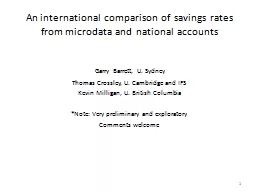PPT-An international comparison of savings rates from microdata and national accounts
Author : studmonkeybikers | Published Date : 2020-06-19
Garry Barrett U Sydney Thomas Crossley U Cambridge and IFS Kevin Milligan U British Columbia Note Very preliminary and exploratory Comments welcome 1 Why does
Presentation Embed Code
Download Presentation
Download Presentation The PPT/PDF document "An international comparison of savings r..." is the property of its rightful owner. Permission is granted to download and print the materials on this website for personal, non-commercial use only, and to display it on your personal computer provided you do not modify the materials and that you retain all copyright notices contained in the materials. By downloading content from our website, you accept the terms of this agreement.
An international comparison of savings rates from microdata and national accounts: Transcript
Download Rules Of Document
"An international comparison of savings rates from microdata and national accounts"The content belongs to its owner. You may download and print it for personal use, without modification, and keep all copyright notices. By downloading, you agree to these terms.
Related Documents














